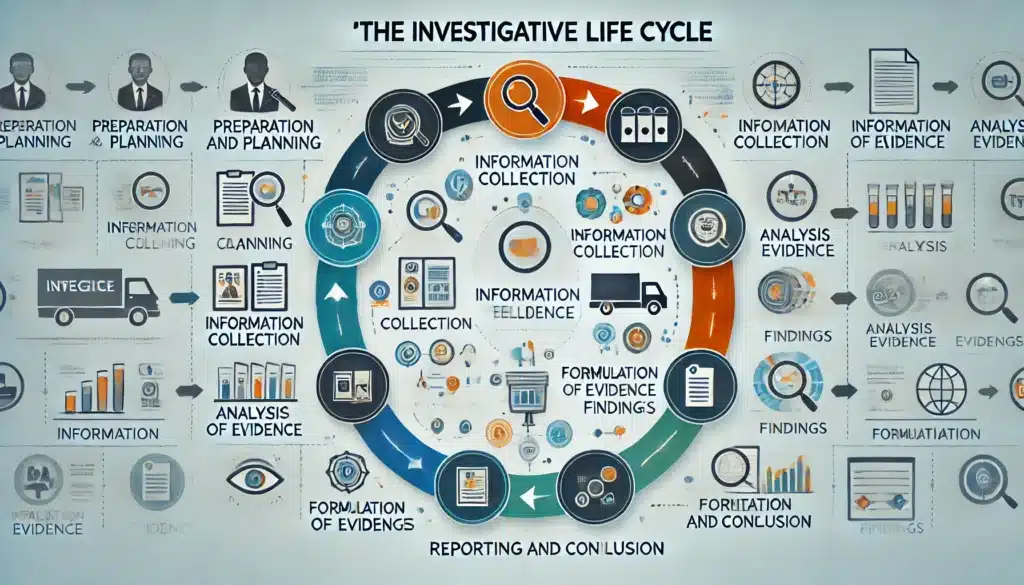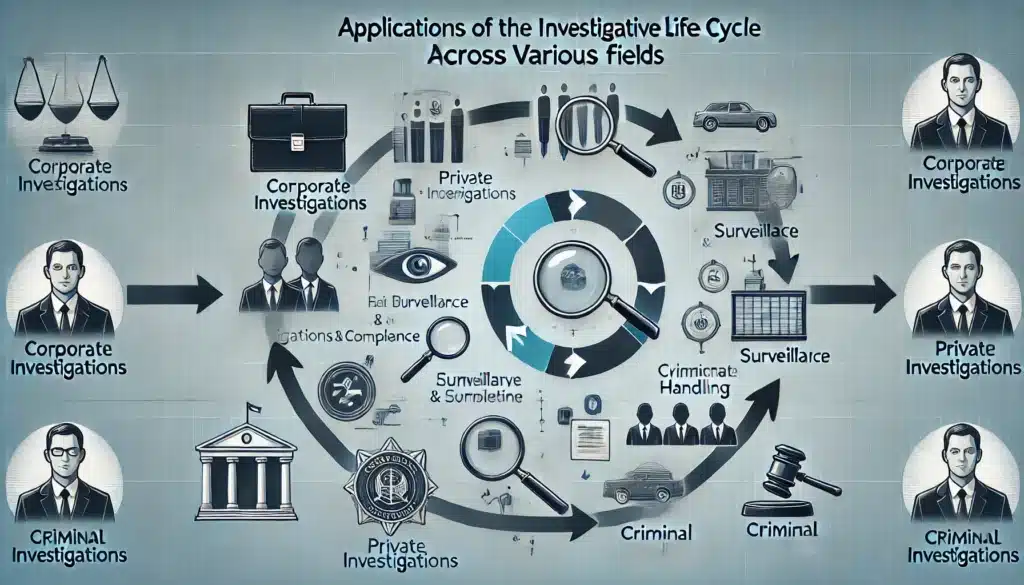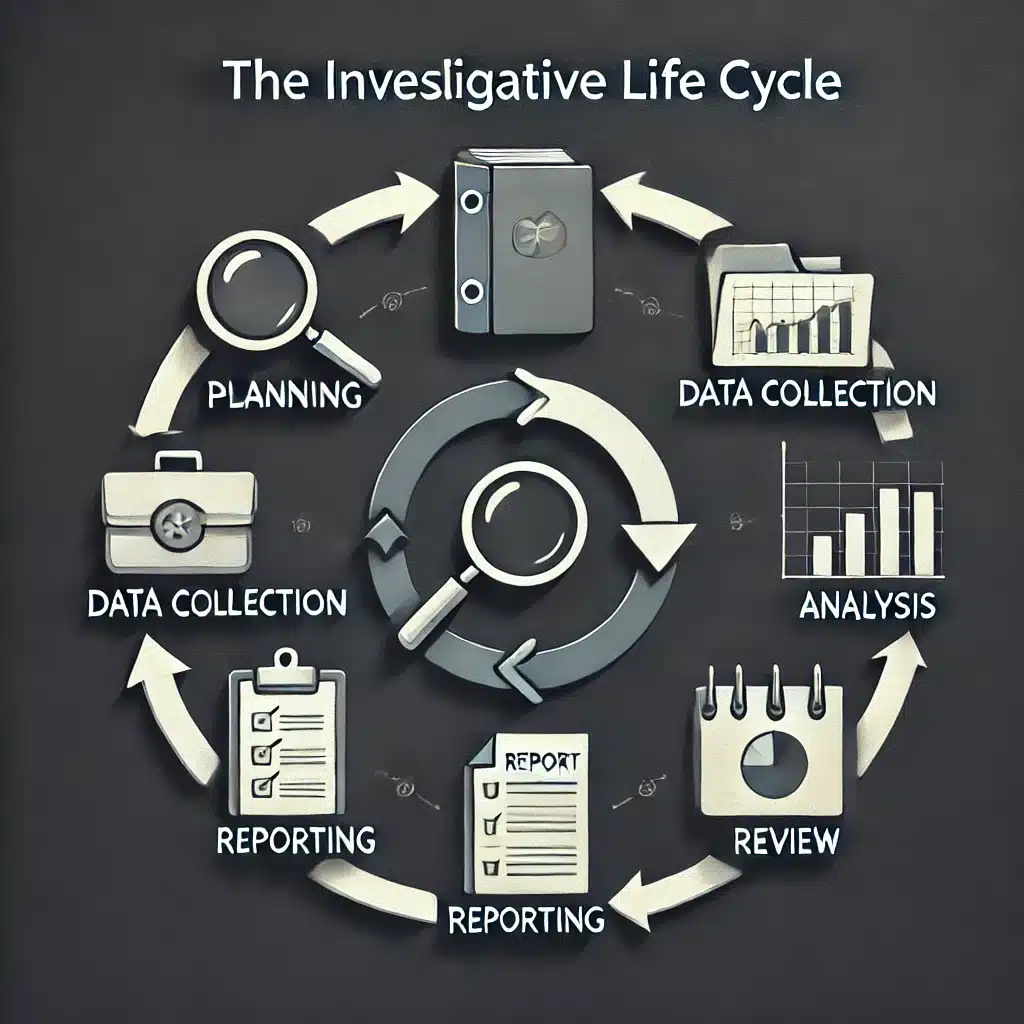The Investigative Life Cycle: A Detailed Look at Each Stage in Professional Investigation
The Investigative Life Cycle: A Comprehensive Guide to the Stages of Professional Investigation

Initial Consultation: Establishing a Foundation for Success
The first step in the investigative life cycle, the initial consultation, is essential for setting a strong foundation for the investigation. This phase includes discussions between the client and investigator, which clarify the investigation’s scope and objectives, provide preliminary guidance on expectations, and ensure all parties are on the same page. Key aspects of this stage include:
- Understanding the Client’s Needs: Investigators discuss the client’s main goals, motivations, and specific needs, which might involve uncovering fraudulent activities, conducting background checks, or tracking information for legal purposes.
- Defining the Scope: By establishing a clear scope, investigators can prevent scope creep—when unexpected elements disrupt the initial investigation parameters. This also ensures efficient resource allocation.
- Setting Realistic Expectations: Timelines, budgets, and expected outcomes are reviewed, allowing the investigator to set achievable goals and maintain transparent communication with the client.
A successful consultation results in a well-aligned understanding between client and investigator, ultimately helping to avoid misunderstandings and delays as the investigation progresses.
2. Intake and Information Gathering: Building a Knowledge Base
Following the consultation, the intake phase involves collecting foundational information necessary to initiate the investigation. This information is key to setting up an efficient investigative plan. Intake activities typically include:
- Collecting Background Information: Investigators gather information such as names, addresses, and contact details related to the subjects or locations involved.
- Researching Public and Private Records: Public records, databases, and prior case information can reveal initial insights and highlight any previous investigations involving the subjects.
- Establishing Preliminary Leads: Investigators identify potential witnesses, gather facts about relevant locations, and create profiles of individuals involved to understand how to approach the investigation.
This phase provides investigators with an initial roadmap, offering critical details that aid in planning the next steps. Comprehensive intake information enables investigators to allocate resources effectively, ensuring that they have the necessary tools and background knowledge for each subsequent stage.
3. Assessment: Evaluating Feasibility, Risks, and Legal Considerations
During the assessment phase, investigators align the investigation’s goals with the client’s budget, timeframe, and risk tolerance. This stage evaluates the potential challenges and complexities of the investigation, often examining the following areas:
- Budget Assessment: Investigations vary widely in cost based on their complexity and scope. Aligning the budget with the investigative goals ensures resource availability and helps avoid mid-process financial challenges.
- Risk Analysis: Investigators assess any risks involved, which might include legal considerations, ethical issues, or security risks. By identifying and planning for these risks, investigators can avoid or mitigate potential obstacles that could compromise the investigation.
- Legal and Ethical Considerations: Each investigative approach is carefully reviewed to ensure it complies with local laws and regulations, preserving the investigation’s integrity and the client’s interests.
This phase ensures that the investigation remains both legally compliant and strategically sound, paving the way for a well-organized and secure process.
4. Preparation: Strategizing and Setting up Tools
In the preparation phase, investigators set the operational plan based on the intake and assessment stages. Effective preparation involves mapping out strategies, establishing protocols, and deploying tools or resources to collect evidence efficiently. Preparation involves several key activities:
- Strategic Planning: Investigators outline specific actions, prioritize tasks, and develop hypotheses to guide the investigation. These preliminary strategies provide a framework that keeps the investigation organized.
- Resource Allocation: Investigators determine the necessary tools, equipment, . This might include surveillance gear, digital data analysis tools, or specialized field operations vehicles.
- Legal Permissions and Compliance: In some cases, investigators need to secure permits or permissions, especially when surveillance or data collection crosses into sensitive areas.
A well-prepared investigator is equipped to handle unexpected challenges and can follow leads systematically without disruption, improving both the efficiency and accuracy of evidence collection.
5. Execution: Conducting Surveillance and Evidence Gathering
The execution phase marks the active stage of the investigation. It’s during this period that investigators put plans into action, employing various methods to gather information, document events, and verify facts. Execution involves several core processes:
- Surveillance and Monitoring: Depending on the case, investigators may conduct physical or digital surveillance, often with video or photo documentation. Surveillance allows investigators to monitor behaviours, actions, and movements, providing real-time insights.
- Interviewing and Interrogation: In cases involving witnesses or persons of interest, skilled interviewing techniques are employed to gather statements. Properly conducted interviews can uncover crucial information or clarify uncertainties.
- Adapting the Investigation: Investigators often need to adjust strategies based on real-time findings. For example, if a new lead surfaces, investigators might expand surveillance or shift resources to explore this development.
Execution requires both precision and flexibility, as new information can change the trajectory of the investigation. Regular updates are typically provided to the client, ensuring transparency and trust throughout the investigative process.
6. Analysis: Interpreting Data and Developing Insights
In the analysis phase, investigators review and interpret the data collected to uncover facts, trends, and patterns that contribute to the overall understanding of the case. This phase is pivotal for transforming raw information into actionable insights. Core components of analysis include:
- Data Validation and Cross-Referencing: Investigators validate findings by cross-referencing data from different sources, ensuring accuracy and reliability.
- Pattern Recognition: Through careful examination, investigators may identify behaviours, trends, or other patterns that add depth to the case narrative.
- Creating a Cohesive Narrative: Investigators connect findings to create a comprehensive storyline that explains the investigation’s progress, findings, and conclusions in a coherent way.
The analysis phase often involves sophisticated tools and software for data analysis, enhancing investigators’ ability to process large volumes of information quickly and efficiently. The outcome is a well-founded interpretation of the facts, preparing investigators for the final reporting stage.
7. Reporting: Presenting Findings and Recommendations
The reporting stage is the culmination of the investigative life cycle, where findings, analyses, and recommendations are compiled into a final document for the client. This report serves as the formal conclusion of the investigation and is often used as a key decision-making tool. Essential components of the reporting phase include:
- Comprehensive Case Summary: The report includes a detailed summary, covering the case’s background, objectives, methods, and significant events observed during the investigation.
- Evidence Documentation: All evidence gathered, from surveillance footage to interview transcripts, is organized and presented to support the findings.
- Recommendations and Next Steps: Investigators often provide clients with actionable recommendations based on the findings. For example, they might suggest further monitoring, legal actions, or specific security measures.
This final report provides a clear, structured, and factual overview that allows the client to understand the investigation’s results and take necessary actions with confidence.
Applications of the Investigative Life Cycle Across Various Fields

Corporate Investigations
In corporate settings, the investigative life cycle helps organizations address issues like fraud, compliance violations, and employee misconduct. Corporate investigators might focus on financial analysis, surveillance, and regulatory compliance to protect company assets and reputation.
Private Investigations
Private investigators often assist individuals or families in cases involving domestic issues, such as suspected infidelity or missing persons. These investigations may rely heavily on surveillance, interviews, and background checks.
Criminal Investigations
Law enforcement agencies follow a similar investigative life cycle in criminal cases, emphasizing legal compliance and evidence handling to ensure information can be presented in court. This cycle helps law enforcement officers gather evidence and build a solid case for prosecution.
Challenges and Ethical Considerations in the Investigative Life Cycle
- Privacy and Confidentiality: Investigators are entrusted with sensitive information and must handle it with care, ensuring that they maintain confidentiality.
- Legal Boundaries: The investigative process often intersects with privacy laws and regulations. Ensuring that evidence-collection methods comply with these laws is essential.
- Objectivity: Investigators must remain neutral and avoid personal bias. Objectivity is essential to ensure that findings are factual and reliable.
In fields like private investigation, ethics are paramount. Professionalism, integrity, and adherence to a strict ethical code help ensure that investigations are both effective and respectful of individual rights.
Conclusion: The Importance of a Structured Approach in Investigation

By following a clearly defined sequence, investigators can ensure that each phase of the investigation contributes meaningfully to the final report, providing clients with actionable and trustworthy insights. This cycle not only facilitates thorough evidence-gathering but also helps maintain transparency, legal compliance, and ethical standards throughout the process.
Whether in private, corporate, or criminal contexts, the investigative life cycle remains a powerful model that brings consistency, thoroughness, and clarity to complex investigative work. This structured approach helps achieve reliable outcomes and fosters a transparent, ethical investigative process, ensuring that the findings contribute effectively to informed decision-making.
https://bbintell.com/corporate-settings-risk-management/
Enhancing Corporate Operations Through Expert Private Investigators Risk Management
Suspecting Infidelity: How to Handle Doubts About Your Spouse’s Fidelity
digital forensics investigation stage, a digital forensics investigation, forensics investigation phase, stages of a digital forensics
digital investigator, digital investigator, forensic investigation process
